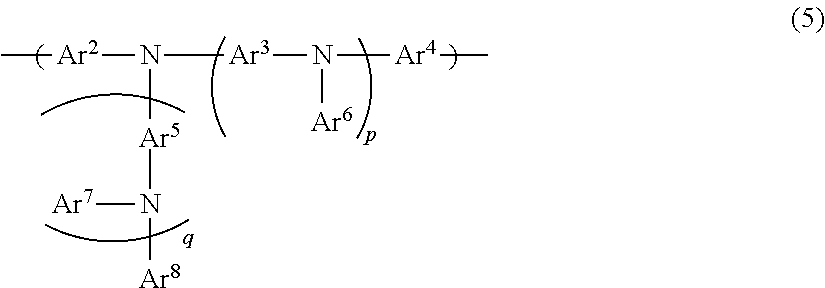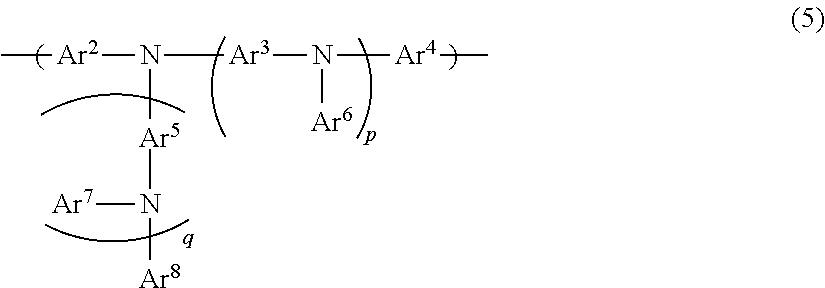Organic electroluminescent device
a technology of electroluminescent devices and organic materials, which is applied in the direction of thermoelectric devices, solid-state devices, organic chemistry, etc., can solve the problems of insufficient luminance life of the electroluminescent device disclosed in the above-described patent document 1
- Summary
- Abstract
- Description
- Claims
- Application Information
AI Technical Summary
Benefits of technology
Problems solved by technology
Method used
Image
Examples
synthesis example 1
Synthesis of Compound M-1
[0331]
[0332]Into a nitrogen-purged reactor were charged 0.90 g of palladium(II) acetate, 2.435 g of tris(2-methylphenyl)phosphine and 125 mL of toluene, and the mixture was stirred at room temperature for 15 minutes. To this were added 27.4 g of 2,7-dibromo-9,9-dioctylfluorene, 22.91 g of (4-methylphenyl)phenylamine and 19.75 g of sodium-tert-butoxide, and the mixture was refluxed with heating overnight, then, cooled down to room temperature, 300 mL of water was added and washing thereof was performed. The organic layer was taken out and the solvent was distilled off under reduced pressure. The residue was dissolved in 100 mL of toluene, the resultant solution was passed through an alumina column. The eluate was concentrated under reduced pressure, to this was added methanol, to cause generation of a precipitate. The precipitate was filtrated, and recrystallized from p-xylene. This crystal was dissolved again in 100 mL of toluene, and the resultant solution ...
synthesis example 2
Synthesis of Compound M-2
[0335]
[0336]Into a nitrogen-purged 500 mL three-necked round bottom flask were charged 196 mg of palladium(II) acetate, 731 mg of tris(2-methylphenyl)phosphine and 100 mL of toluene, and the mixture was stirred at room temperature. To the reaction solution were added 20.0 g of diphenylamine, 23.8 g of 3-bromobicyclo[4.2.0]octa-1,3,5-triene and 400 mL of toluene, subsequently, 22.8 g of sodium-tert-butoxide, and the mixture was refluxed with heating for 22 hours. To this was added 30 mL of 1M hydrochloric acid, to stop the reaction. The resultant reaction mixture was washed with 100 mL of a 2M sodium carbonate aqueous solution, the organic layer was passed through alumina, the eluate was collected, and the solvent was distilled off from this under reduced pressure. To the resultant oily yellow residue was added isopropyl alcohol, then, the mixture was stirred, and the generated precipitate was filtrated. This precipitate was recrystallized from isopropyl alco...
synthesis example 3
Synthesis of Compound M-3
[0339]
[0340]Into a 300 ml four-necked flask were charged 8.08 g of 1,4-dihexyl-2,5-dibromobenzene, 12.19 g of bis(pinacolate)diboron and 11.78 g of potassium acetate, and an atmosphere in the flask was purged with argon. Into this was charged 100 ml of dehydrated 1,4-dioxane, and the mixture was deaerated with argon. Into this was charged 0.98 g of [1,1′-bis(diphenylphosphino)ferrocene]dichloropalladium(II) (Pd(dppf)2Cl2), and the mixture was further deaerated with argon. The resultant mixed liquid was refluxed with heating for 6 hours. To the reaction solution was added toluene, and the mixture was washed with ion exchanged water. To the washed organic layer were added anhydrous sodium sulfate and activated carbon, and the mixture was filtrated through a funnel pre-coated with celite. The resultant filtrate was concentrated, to obtain 11.94 g of a dark brown crystal. This crystal was recrystallized from n-hexane, and the crystal was washed with methanol. Th...
PUM
| Property | Measurement | Unit |
|---|---|---|
| Molar density | aaaaa | aaaaa |
| Fraction | aaaaa | aaaaa |
| Time | aaaaa | aaaaa |
Abstract
Description
Claims
Application Information
 Login to View More
Login to View More - R&D
- Intellectual Property
- Life Sciences
- Materials
- Tech Scout
- Unparalleled Data Quality
- Higher Quality Content
- 60% Fewer Hallucinations
Browse by: Latest US Patents, China's latest patents, Technical Efficacy Thesaurus, Application Domain, Technology Topic, Popular Technical Reports.
© 2025 PatSnap. All rights reserved.Legal|Privacy policy|Modern Slavery Act Transparency Statement|Sitemap|About US| Contact US: help@patsnap.com



